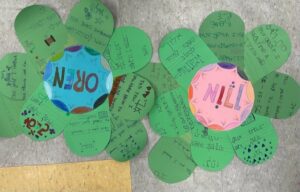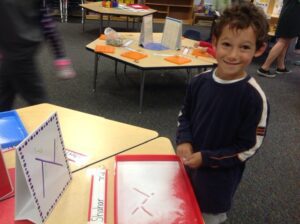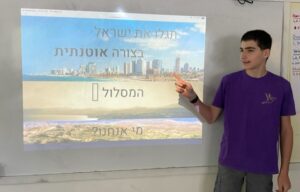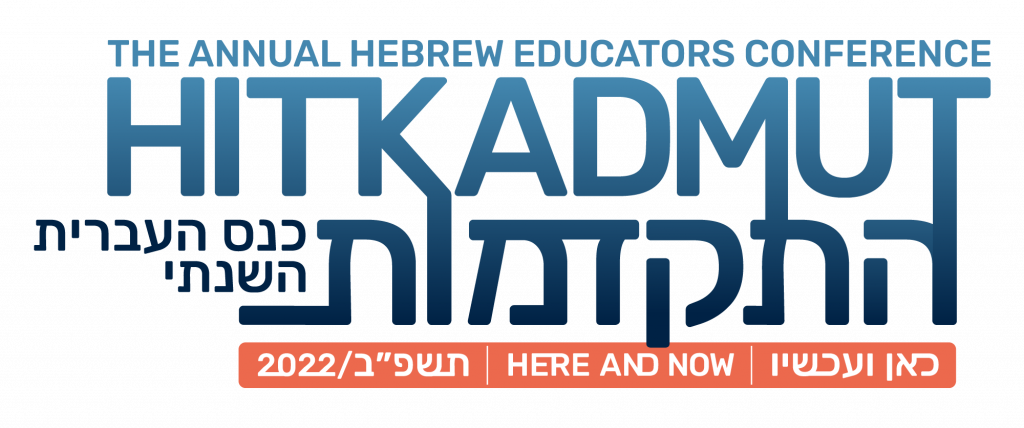Hebrew to follow לעברית, אנא ראו בהמשך

At JCDS, Boston’s Jewish Community Day School in Watertown, MA, Hebrew is a window into Israeli culture, and it is with this understanding and focus that it is taught to their students; Hebrew language IS at their center! When JCDS founder Arnee Winshall was recently asked why Israel was integral to the founders’ original mission of the school, her response was: “Our entire approach was to connect to Israel through creating a dual language and a dual culture environment, where the spirit of Israel would be in the air. A place where we sing Israeli songs, learn Israeli dance, celebrate holidays, cuisine, and history: find ways to integrate Hebrew and Israel throughout the curriculum, and even make it so on some days you wouldn’t know whether you were in the US or in Israel”.
Coupled with this vision, and as a pluralistic, 21st century cutting-edge bicultural institution of learning, JCDS has always recognized that exposure to foreign language is crucial in developing its students’ global awareness and appreciation for interconnectedness. At JCDS, Hebrew extends well beyond the classroom. It is heard in the art room, the hader ochel (dining hall) throughout the hallways, on the playing fields, and it is seen in displays and on bulletin boards. As Head of Hebrew and Judaic Studies, Dorit Zmiri told us, “Through Hebrew, our students are exposed and organically acculturated to the land of Israel and its people”.
How does JCDS manage to sustain and maintain such a strong Hebrew program?

A deliberate decision was made early on in the school’s development, that each Lower School classroom would be home to two full time teachers: an English speaker and a native Hebrew one who would consistently speak their native tongue throughout the day. Within this natural language environment, children are exposed to authentic parlance, speech, and everyday dialect. Be it conversations, stories, talk of feelings and emotions, humor, or the simple giving of directions, the children hear it all in genuine language. As well, the fine arts at JCDS: their music, art, and dance programs are taught entirely in Hebrew (with an occasional English translation if needed).
Hebrew learning begins in Gan Nitzan and culminates in 8th grade, but at the core of JCDS is that Hebrew language acquisition is assessment based. Every student is evaluated annually through OPI, the Oral Proficiency Interview, and based on progress monitoring, placed at an appropriate level to maximize their learning. With Sharona Givol at the helm of their Hebrew program for nearing two decades, she developed marvelous units for the learner according to their Hebrew proficiency level and age appropriateness.
As a result of the Corona pandemic, two major changes transpired at the school. Early on came a 25% increase in students arriving from local public schools with little to no Hebrew background. Conversely, the following year, on
ce some of the restrictions were lifted, several Israeli students arrived at once, speaking almost no English. To address these two opposing challenges, JCDS expediently developed, out of necessity, and in keeping with their original mission, classes to accommodate and meet every student at their individual level, including, for the very first time in its history, an entire year’s unit for 8th grade native Hebrew speakers. Throughout this sophisticated unit, students create a website in which they explore giving tours around Israel that include information about history, environment, geography and the demographics of its citizens. As well, they create a complete marketing package for schools from abroad wishing to tour The Israel Trail, a hiking path that extends across the country from north to south.
JCDS students, from Gan Nitzan through 8th grade, live and breathe Hebrew in an authentic bicultural, bilingual environment that was, and will always remain, at their center.
בית ספר JCDS הוקם על מנת ליצור סביבת למידה שבה התלמידים נעים בנוחות בין שתי התרבויות; האמריקאית והישראלית.

לדברי דורית זמירי ראש המחלקה לעברית ב– JDCS, מייסדי בית הספר חזו בית ספר בבוסטון שבו התרבות הישראלית חיה, עשירה ואותנטית ככל האפשר, וניתן לראותה ולחוש אותה במסדרונות בית הספר, בכיתות, במגרש המשחקים, ובחדר האוכל.
כיצד הצליח JCDS לקיים ולשמור על סביבת עברית חזקה כל כך במשך כל השנים הללו?
המחויבות של ארני ווינשל, ממייסדי בית הספר,לשפה העברית ולפלורליזם הפכה אותם לחלק חשוב מהחזון והפילוסופיה החינוכית של בית הספר, ושמרה על קיומם לאורך השנים.
מחשבה ומשאבים רבים הושקעו בבניית סביבה דו-לשוניתב-JCDS. למשל, בחטיבת היסודי, עובדים במקביל באותה כיתה שני מורים, דובר עברית ודובר אנגלית המדברים את שפתם לאורך כל היום. כמו גם שיעורי אמנות, מחול ומוסיקה מתנהלים בעברית מתוך כוונה לחשוף כמה שיותר את התלמידים לשפה העברית. באותה מידה מצופה מהמורים להביע את מחשבותיהם ורגשותיהם בשפה הנוחה להם באופן מלא ואותנטי, ובמידת הצורך מישהו אחר יתרגם את דבריהם לטובת מי שאינו מבין את שפתם.
העברית ב– JCDS נמצאת במרכז, בלמידה הפורמלית והחוויתית כאחד. ההוראה בכיתה נערכת בשפה העברית ומתמקדת במיומנויות השפה: דיבור, האזנה, קריאה וכתיבה. התוכנית מבוססת על מנגנון הערכה המלווה את התלמידים לאורך תקופת שהותם בבית הספר. הערכה זו מאפשרת מעקב אחר התקדמות הלומדים ויצירת חומרי לימוד מותאמים לצרכיהם. ברשות בית הספר הצטברו עד כה יותר מעשרים שנה של נתונים על הישגי הלומדים על פי סולם ACTFL.
במהלך השנים האחרונות, עקב מגפת הקורונה, התרחשו שני שינויים דמוגרפיים שהיוו אתגר להקניית השפה העברית בבית הספר. מחד, הגיעו תלמידים רבים מבתי ספר ציבוריים ללא רקע בעברית, מאידך, הגיעו תלמידים ישראלים ללא ידע בשפה האנגלית. על מנת לענות לצרכים השונים של תלמידים אלו, נפתחו כיתות מכינה ללימוד העברית, וכיתות ELL ללימוד אנגלית עבור דוברי העברית.
בפעם הראשונה נפתחה כיתה לרמת דוברי עברית (ישראלים) שהצריכה תכנית לימודים שונה ויצירת יחידות לימוד חדשניות. שרונה גיבעול, שבמשך שנים עמדה בראש המחלקה לעברית ופיתחה את כל יחידות הלימוד, ענתה לאתגר ופיתחה יחידת לימוד חדשה – ״שביל ישראל״ -מסלול טיולים המשתרע לכל אורכה של ישראל. כל תלמיד בכיתה ח׳ קיבל משימה של מדריך טיולים לקטע אחר בשביל ישראל, ויצר תוכנית שיווקית מלאה לבתי ספר מחו״ל שרוצים לטייל. כל תלמיד הקים אתר אינטרנט בעברית שכלל מידע חברתי, סביבתי, דמוגרפי והיסטורי ובנוסף אפשרויות לינה, תחבורה, ארוחות ,בידור ותקציב.
יכולת בית הספר לקיים סביבה דו תרבותית ודו לשונית שבה חיים ונושמים את התרבות הישראלית עד כמה שניתן לעשות זאת מחוץ לישראל, מעידה על המחוייבות לחזון בית הספר והתאמתו לנסיבות הזמן.


